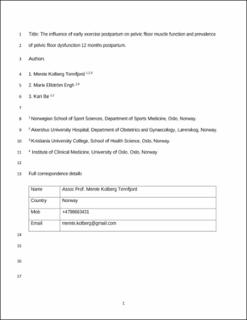The Influence of Early Exercise Postpartum on Pelvic Floor Muscle Function and Prevalence of Pelvic Floor Dysfunction 12 Months Postpartum
Peer reviewed, Journal article
Accepted version
Permanent lenke
https://hdl.handle.net/11250/3005697Utgivelsesdato
2020Metadata
Vis full innførselSammendrag
Objective: There is limited knowledge on how exercise impacts the pelvic floor muscles (PFM) and prevalence of stress urinary incontinence (SUI) and pelvic organ prolapse (POP) postpartum. The purpose of this study was to investigate whether early onset of general exercise postpartum negatively affects the PFM and/or increases the risk of SUI and POP 12 months postpartum. Methods: This study used a prospective cohort design. At 6 weeks postpartum, 57 women classified as exercisers (exercising ≥3 times at ≥30 min/week) were compared with 120 nonexercisers (mean age = 29 y, SD = 4.3). Manometry was used to measure vaginal resting pressure (VRP), PFM strength, and PFM endurance, and symptoms of SUI and POP were assessed using questionnaires. Data were presented as standardized beta coefficients (B) and odds ratios (OR). Results: No differences were found between exercisers (n = 57) and nonexercisers (n = 120) at 6 weeks postpartum on VRP (B = −0.04 [95% CI = −3.4 to 2.1]), PFM strength (B = 0.03 [95% CI = −4.7 to 7.4]), PFM endurance (B = −0.02 [95% CI = −59 to 46]), or symptoms of SUI (OR = 0.51 [95% CI = 0.25 to 1.1]) or POP (OR = 0.62 [95% CI = 0.26 to 1.5]) measured at 12 months postpartum. Adjusting for covariates, women with body mass index between 25 and 29.9 and > 30 were more likely to report SUI 12 months postpartum (OR = 2.2 [95% CI = 1.0 to 4.7] and OR = 3.3 [95% CI = 1.2 to 9.4], respectively). Women with physically strenuous occupations were more likely to report POP 12 months postpartum (OR = 3.0 [95%CI: 1.2 to 7.3]). Conclusions: This study suggests that regular exercise 6 weeks postpartum has no negative effect on PFM function or on SUI or POP. Being overweight, however, was associated with more SUI, and women with physically strenuous occupations reported more POP. Impact: Results from this study suggest that first time mothers should be encouraged to start general exercise within the first 6 weeks after giving birth. Women at risk for PFD should be advised accordingly and potentially modifiable risk factors should be addressed prior to delivery.
